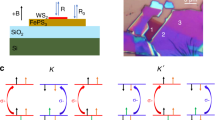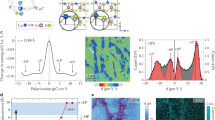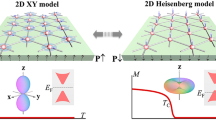Abstract
Ferroelectric ferromagnets are exceedingly rare, fundamentally interesting multiferroic materials that could give rise to new technologies in which the low power and high speed of field-effect electronics are combined with the permanence and routability of voltage-controlled ferromagnetism1,2. Furthermore, the properties of the few compounds that simultaneously exhibit these phenomena1,2,3,4,5 are insignificant in comparison with those of useful ferroelectrics or ferromagnets: their spontaneous polarizations or magnetizations are smaller by a factor of 1,000 or more. The same holds for magnetic- or electric-field-induced multiferroics6,7,8. Owing to the weak properties of single-phase multiferroics, composite and multilayer approaches involving strain-coupled piezoelectric and magnetostrictive components are the closest to application today1,2. Recently, however, a new route to ferroelectric ferromagnets was proposed9 by which magnetically ordered insulators that are neither ferroelectric nor ferromagnetic are transformed into ferroelectric ferromagnets using a single control parameter, strain. The system targeted, EuTiO3, was predicted to exhibit strong ferromagnetism (spontaneous magnetization, ∼7 Bohr magnetons per Eu) and strong ferroelectricity (spontaneous polarization, ∼10 µC cm−2) simultaneously under large biaxial compressive strain9. These values are orders of magnitude higher than those of any known ferroelectric ferromagnet and rival the best materials that are solely ferroelectric or ferromagnetic. Hindered by the absence of an appropriate substrate to provide the desired compression we turned to tensile strain. Here we show both experimentally and theoretically the emergence of a multiferroic state under biaxial tension with the unexpected benefit that even lower strains are required, thereby allowing thicker high-quality crystalline films. This realization of a strong ferromagnetic ferroelectric points the way to high-temperature manifestations of this spin–lattice coupling mechanism10. Our work demonstrates that a single experimental parameter, strain, simultaneously controls multiple order parameters and is a viable alternative tuning parameter to composition11 for creating multiferroics.
This is a preview of subscription content, access via your institution
Access options
Subscribe to this journal
Receive 51 print issues and online access
$199.00 per year
only $3.90 per issue
Buy this article
- Purchase on Springer Link
- Instant access to full article PDF
Prices may be subject to local taxes which are calculated during checkout




Similar content being viewed by others
References
Eerenstein, W., Mathur, N. D. & Scott, J. F. Multiferroic and magnetoelectric materials. Nature 442, 759–765 (2006)
Ramesh, R. & Spaldin, N. A. Multiferroics: progress and prospects in thin films. Nature Mater. 6, 21–29 (2007)
Rivera, J.-P. & Schmid, H. Electrical and optical measurements on nickel iodine boracite. Ferroelectrics 36, 447–450 (1981)
Ikeda, N. et al. Ferroelectricity from iron valence ordering in the charge-frustrated system LuFe2O4 . Nature 436, 1136–1138 (2005)
Park, J. Y., Park, J. H., Jeong, Y. K. & Jang, H. M. Dynamic magnetoelectric coupling in “electronic ferroelectric” LuFe2O4 . Appl. Phys. Lett. 91, 152903 (2007)
Kimura, T. et al. Magnetic control of ferroelectric polarization. Nature 426, 55–58 (2003)
Lottermoser, T. et al. Magnetic phase control by an electric field. Nature 430, 541–544 (2004)
Kimura, T., Sekio, Y., Nakamura, H., Siegrist, T. & Ramirez, A. P. Cupric oxide as an induced-multiferroic with high-Tc . Nature Mater. 7, 291–294 (2008)
Fennie, C. J. & Rabe, K. M. Magnetic and electric phase control in epitaxial EuTiO3 from first principles. Phys. Rev. Lett. 97, 267602 (2006)
Lee, J. H. & Rabe, K. M. Epitaxial-strain-induced multiferroicity in SrMnO3 from first principles. Phys. Rev. Lett. 104, 207204 (2010)
Goto, T., Kimura, T., Lawes, G., Ramirez, A. P. & Tokura, Y. Ferroelectricity and giant magnetocapacitance in perovskite rare-earth manganites. Phys. Rev. Lett. 92, 257201 (2004)
Nguyen, L. D., Brown, A. S., Thompson, M. A. & Jelloian, L. M. 50-nm self-aligned-gate pseudomorphic AlInAs/GaInAs high electron mobility transistors. IEEE Trans. Electron. Dev. 39, 2007–2014 (1992)
Bozovic, I., Logvenov, G., Belca, I., Narimbetov, B. & Sveklo, I. Epitaxial strain and superconductivity in La2–xSrxCuO4 thin films. Phys. Rev. Lett. 89, 107001 (2002)
Beach, R. S. et al. Enhanced Curie temperatures and magnetoelastic domains in Dy/Lu superlattices and films. Phys. Rev. Lett. 70, 3502–3505 (1993)
Fuchs, D. et al. Tuning the magnetic properties of LaCoO3 thin films by epitaxial strain. Phys. Rev. B 77, 014434 (2008)
Choi, K. J. et al. Enhancement of ferroelectricity in strained BaTiO3 thin films. Science 306, 1005–1009 (2004)
Pertsev, N. A., Tagantsev, A. K. & Setter, N. Phase transitions and strain-induced ferroelectricity in SrTiO3 epitaxial thin films. Phys. Rev. B 61, R825–R829 (2000)
Haeni, J. H. et al. Room-temperature ferroelectricity in strained SrTiO3 . Nature 430, 758–761 (2004)
Katsufuji, T. & Takagi, H. Coupling between magnetism and dielectric properties in quantum paraelectric EuTiO3 . Phys. Rev. B 64, 054415 (2001)
Shvartsman, V. V., Borisov, P., Kleemann, W. & Kamba, S. &. Katsufuji, T. Large off-diagonal magnetoelectric coupling in the quantum paraelectric antiferromagnet EuTiO3 . Phys. Rev. B 81, 064426 (2010)
Junquera, J. & Ghosez, P. Critical thickness for ferroelectricity in perovskite ultrathin films. Nature 422, 506–509 (2003)
Fong, D. D. et al. Ferroelectricity in ultrathin perovskite films. Science 304, 1650–1653 (2004)
Chu, M.-W. et al. Impact of misfit dislocations on the polarization instability of epitaxial nanostructured ferroelectric perovskites. Nature Mater. 3, 87–90 (2004)
Lee, J. H. et al. Optical band gap and magnetic properties of unstrained EuTiO3 films. Appl. Phys. Lett. 94, 212509 (2009)
Ke, X. et al. Low temperature magnetism in the perovskite substrate DyScO3 . Appl. Phys. Lett. 94, 152503 (2009)
Zhai, J. Y., Xing, Z. P., Dong, S. X., Li, J. F. & Viehland, D. Detection of pico-Tesla magnetic fields using magneto-electric sensors at room temperature. Appl. Phys. Lett. 88, 062510 (2006)
Gajek, M. et al. Tunnel junctions with multiferroic barriers. Nature Mater. 6, 296–302 (2007)
Bayrashev, A., Robbins, W. P. & Ziaie, B. Low frequency wireless powering of microsystems using piezoelectric-magnetostrictive laminate composites. Sens. Actuators A 114, 244–249 (2004)
Fetisov, Y. K. & Srinivasan, G. Electric field tuning characteristics of a ferrite-piezoelectric microwave resonator. Appl. Phys. Lett. 88, 143503 (2006)
Das, J., Song, Y.-Y., Mo, N., Krivosik, P. & Patton, C. E. Electric-field-tunable low loss multiferroic ferrimagnetic-ferroelectric heterostructures. Adv. Mater. 21, 2045–2049 (2009)
Brous, J., Fankuchen, I. & Banks, E. Rare earth titanates with a perovskite structure. Acta Crystallogr. 6, 67–70 (1953)
Wang, H.-H., Fleet, A., Brock, J. D., Dale, D. & Suzuki, Y. Nearly strain-free heteroepitaxial system for fundamental studies of pulsed laser deposition: EuTiO3 on SrTiO3 . J. Appl. Phys. 96, 5324–5328 (2004)
Kugimiya, K., Fujita, K., Tanaka, K. & Hirao, K. Preparation and magnetic properties of oxygen deficient EuTiO3–δ thin films. J. Magn. Magn. Mater. 310, 2268–2270 (2007)
Chae, S. C. et al. Magnetic properties of insulating RTiO3 thin films. J. Electroceram. 22, 216–220 (2009)
Fujita, K., Wakasugi, N., Murai, S., Zong, Y. & Tanaka, K. High-quality antiferromagnetic EuTiO3 epitaxial thin films on SrTiO3 prepared by pulsed laser deposition and postannealing. Appl. Phys. Lett. 94, 062512 (2009)
Hatabayashi, K. et al. Fabrication of EuTiO3 epitaxial thin films by pulsed laser deposition. Jpn. J. Appl. Phys. 48, 100208 (2009)
Theis, C. D. & Schlom, D. G. Cheap and stable titanium source for use in oxide molecular beam epitaxy systems. J. Vac. Sci. Technol. A 14, 2677–2679 (1996)
Schlom, D. G. et al. Strain tuning of ferroelectric thin films. Annu. Rev. Mater. Res. 37, 589–626 (2007)
Steins, M., Doerschel, J. & Reiche, P. Crystal structure of aluminium lanthanum strontium tantalum oxide, (La0. 272Sr0. 728)(Al0. 648Ta0. 352)O3 . Z. Kristallogr. New Cryst. Struct. 212, 77 (1997)
Hellwege, K.-H. & Hellwege, A. M. (eds) Landolt-Börnstein: Numerical Data and Functional Relationships in Science and Technology New Series, Group III, Vol. 16a 59 (Springer, 1981)
Koster, G., Kropman, B. L., Rijnders, G., Blank, D. H. A. & Rogalla, H. Quasi-ideal strontium titanate crystal surfaces through formation of strontium hydroxide. Appl. Phys. Lett. 73, 2920–2922 (1998)
Veličkov, B., Kahlenberg, V., Bertram, R. & Bernhagen, M. Crystal chemistry of GdScO3, DyScO3, SmScO3, and NdScO3 . Z. Kristallogr. 222, 466–473 (2007)
Anisimov, V. I., Aryasetiawan, F. & Lichtenstein, A. I. First-principles calculations of the electronic structure and spectra of strongly correlated systems: the LDA+U method. J. Phys. Condens. Matter 9, 767–808 (1997)
Kresse, G. & Hafner, J. Ab initio molecular dynamics for liquid metals. Phys. Rev. B 47, 558–561 (1993)
Blochl, P. E. Projector augmented-wave method. Phys. Rev. B 50, 17953–17979 (1994)
Kresse, G. & Furthmuller, J. Efficient iterative schemes for ab initio total-energy calculations using a plane-wave basis set. Phys. Rev. B 54, 11169–11186 (1996)
Kresse, G. & Joubert, D. From ultrasoft pseudopotentials to the projector augmented-wave method. Phys. Rev. B 59, 1758–1775 (1999)
Acknowledgements
The authors acknowledge discussions and interactions with M. D. Biegalski, D. H. A. Blank, C. B. Eom, M. B. Holcomb, M. Ležaić, J. Mannhart, L. W. Martin, D. V. Pelekhov, R. Ramesh, K. Z. Rushchanskii, N. Samarth, A. Schmehl, D. A. Tenne, J.-M. Triscone, D. Viehland and L. Yan. In addition, the financial support of the National Science Foundation through grant DMR-0507146 and the MRSEC program (DMR-0520404, DMR-0820404 and DMR-0820414), and of the Czech Science Foundation (project no. 202/09/0682), is gratefully acknowledged. Use of the Advanced Photon Source was supported by the US Department of Energy, Office of Science, Office of Basic Energy Sciences, under contract no. DE-AC02-06CH11357.
Author information
Authors and Affiliations
Contributions
The first-principles calculations were performed by C.J.F. and K.M.R. The thin films were synthesized by J.H.L. and D.G.S. on single-crystal substrates including DyScO3 grown by M.B. and R.U. The films were characterized using the MOKE by L.F., Y.W.J., P.C.H. and E.J.-H.; by SHG by E.V. and V. Gopalan; using a SQUID and by capacitance by X.K. and P.S.; by electron microscopy and spectroscopy by L.F.K. and D.A.M.; by X-ray diffraction by J.H.L., J.W.K. and P.J.R.; by X-ray absorption spectroscopy and X-ray magnetic circular dichroism by J.W.F.; by Rutherford backscattering spectrometry by T.H., M.R. and J.S.; and by far-infrared reflectance by V. Goian and S.K. D.G.S., C.J.F., J.W.F. and J.H.L. wrote the manuscript.
Corresponding author
Ethics declarations
Competing interests
The authors declare no competing financial interests.
Supplementary information
Supplementary Information
This file contains Supplementary Figures 1 - 16 with Legends, Supplementary Discussions 1- 8, Supplementary Equations 1 - 2, Supplementary Table 1 and References. (PDF 2535 kb)
Rights and permissions
About this article
Cite this article
Lee, J., Fang, L., Vlahos, E. et al. A strong ferroelectric ferromagnet created by means of spin–lattice coupling. Nature 466, 954–958 (2010). https://doi.org/10.1038/nature09331
Received:
Accepted:
Issue Date:
DOI: https://doi.org/10.1038/nature09331
This article is cited by
-
Transport behaviors of topological band conduction in KTaO3’s two-dimensional electron gases
npj Quantum Materials (2022)
-
Orbital selective switching of ferromagnetism in an oxide quasi two-dimensional electron gas
npj Quantum Materials (2022)
-
Ferroelectricity coexisted with p-orbital ferromagnetism and metallicity in two-dimensional metal oxynitrides
npj Computational Materials (2022)
-
Hybrid improper ferroelectricity in A-cation ordered perovskite BaSrBi\(_2\)O\(_6\)
Journal of the Korean Physical Society (2022)
-
Experimental realization of strain-induced room-temperature ferroelectricity in SrMnO3 films via selective oxygen annealing
NPG Asia Materials (2021)
Comments
By submitting a comment you agree to abide by our Terms and Community Guidelines. If you find something abusive or that does not comply with our terms or guidelines please flag it as inappropriate.



